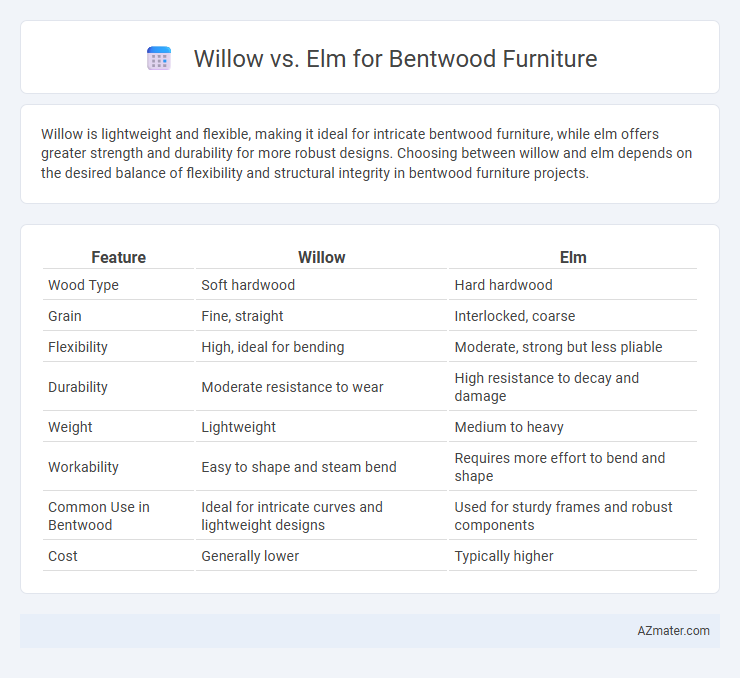Willow is lightweight and flexible, making it ideal for intricate bentwood furniture, while elm offers greater strength and durability for more robust designs. Choosing between willow and elm depends on the desired balance of flexibility and structural integrity in bentwood furniture projects.
Table of Comparison
| Feature | Willow | Elm |
|---|---|---|
| Wood Type | Soft hardwood | Hard hardwood |
| Grain | Fine, straight | Interlocked, coarse |
| Flexibility | High, ideal for bending | Moderate, strong but less pliable |
| Durability | Moderate resistance to wear | High resistance to decay and damage |
| Weight | Lightweight | Medium to heavy |
| Workability | Easy to shape and steam bend | Requires more effort to bend and shape |
| Common Use in Bentwood | Ideal for intricate curves and lightweight designs | Used for sturdy frames and robust components |
| Cost | Generally lower | Typically higher |
Introduction to Bentwood Furniture
Bentwood furniture, renowned for its lightweight yet durable design, often features wood types such as willow and elm due to their flexible grain and strength. Willow's pliability allows for intricate curves essential in bentwood craftsmanship, while elm's interlocking grain provides resistance to splitting under bending pressure. Choosing between willow and elm directly influences the furniture's resilience, aesthetic appeal, and overall manufacturing process in bentwood production.
Overview of Willow and Elm Wood
Willow wood is lightweight, flexible, and known for its smooth grain, making it ideal for bentwood furniture that requires delicate curves and intricate shapes. Elm wood offers exceptional strength, interlocking grain patterns, and high resistance to splitting, providing durability and stability for robust bentwood pieces. Both woods are favored in traditional bentwood craftsmanship, with willow excelling in pliability and elm in toughness.
Key Characteristics of Willow for Bentwood
Willow, prized for its lightweight and flexible properties, excels in bentwood furniture where smooth curves and intricate shapes are essential. Its fine grain and high pliability allow artisans to bend and shape wood without cracking, making it ideal for detailed craftsmanship. Willow also offers durability and a smooth finish, enhancing both the aesthetic and functional quality of bentwood pieces.
Key Characteristics of Elm for Bentwood
Elm wood for bentwood furniture is prized for its exceptional interlocking grain pattern, which enhances resistance to splitting during bending processes. Its natural elasticity and durability make elm ideal for curved designs, providing a strong yet flexible material that maintains shape over time. The wood's coarse texture and rich warmth contribute to aesthetically pleasing and long-lasting bentwood pieces.
Workability and Steaming Properties
Willow wood offers exceptional workability for bentwood furniture due to its fine grain and flexibility, allowing smooth and precise bends without cracking. Elm is highly regarded for its superior steaming properties, as its interlocking grain structure resists splitting and maintains strength during the bending process. Both woods provide durability and aesthetic appeal, but willow excels in ease of shaping while elm ensures structural integrity during steaming.
Durability and Longevity Comparison
Willow wood offers moderate durability and a lightweight structure, making it suitable for bentwood furniture that requires flexibility but less exposure to heavy wear. Elm wood, known for its interlocking grain, provides superior strength and resistance to splitting, enhancing the longevity of bentwood furniture under regular use. For projects prioritizing durability and long-term use, elm is often the preferred choice due to its robustness compared to the softer, less dense willow.
Aesthetic Appeal and Grain Differences
Willow offers a smooth, fine grain with a light, uniform color that enhances the delicate curves of bentwood furniture, promoting an elegant and airy aesthetic. Elm features a more pronounced, interlocking grain pattern with varied tones, providing a rustic, textured appearance that adds character and depth to furniture designs. Choosing willow emphasizes sleek, modern lines, while elm highlights organic complexity and natural charm.
Sustainability and Environmental Impact
Willow and elm are both popular choices for bentwood furniture due to their flexibility and strength, but willow stands out for its rapid growth rate and lower environmental footprint. Willow trees mature in as little as 3-5 years, enabling sustainable harvesting cycles, while elm typically takes longer to grow and is more vulnerable to diseases like Dutch elm disease, impacting long-term supply. Using willow reduces deforestation pressure and promotes carbon sequestration, contributing positively to eco-friendly furniture manufacturing.
Cost and Availability Factors
Willow offers a more cost-effective option for bentwood furniture due to its rapid growth and widespread availability, resulting in lower material prices. Elm, while prized for its strength and beautiful grain patterns, tends to be more expensive and less readily available due to slower growth rates and limited supply. Cost-conscious manufacturers often prefer willow for large-scale production, whereas designers seeking premium aesthetics may opt for elm despite the higher expense.
Best Choice for Bentwood Furniture: Willow vs Elm
Elm wood offers superior durability and strength for bentwood furniture, making it an excellent choice for long-lasting pieces that withstand repeated bending and use. Willow, while more flexible and lightweight, is prone to splintering and may lack the resilience needed for structural furniture components. For best performance and longevity in bentwood furniture, elm is generally the preferred material due to its balanced combination of flexibility and toughness.

Infographic: Willow vs Elm for Bentwood Furniture
 azmater.com
azmater.com